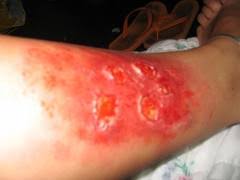What causes pressure sores?
Things that cause pressure sores include:
Pressure on the skin and tissues. This is the most common cause.
Sliding down in a bed or chair, which can cause the skin to fold over itself (shear force).
Being pulled across bed sheets or other surfaces, which can cause friction burns.
Excess moisture, such as from sweat, urine, or feces. Skin that is often wet is more likely to break down and form pressure sores.
What increases the risk of getting pressure sores?
Things that make a person more likely to get pressure sores include:
Not being able to move easily. This often happens because of a spinal injury, paralysis, coma, or surgery.
Poor bladder or bowel control.
Poor nutrition. A diet that doesn't have enough protein can lead to unhealthy skin and slow healing.
Decreased alertness, which may be due to a health problem or taking certain medicines. People who are not alert may not take the steps to prevent pressure sores or understand why prevention is important.
Aging. As people age, their skin becomes thinner, drier, and less elastic, so it is more easily injured.
Smoking. Smoking dries out the skin and reduces blood flow to the skin.
Having a health problem that interferes with healing, such as diabetes.
Caring for a Pressure Sore
Stage I or II sores will heal if cared for carefully. Stage III and IV sores are harder to treat and may take a long time to heal. Here's how to care for a pressure sore at home.
Relieve the pressure on the area.
Use special pillows, foam cushions, booties, or mattress pads to reduce the pressure. Some pads are water- or air-filled to help support and cushion the area. What type of cushion you use depends on your wound and whether you are in bed or in a wheelchair. Talk with your doctor about what choices would be best for you, including what shapes and types of material.
Change positions often. If you are in a wheelchair, try to change your position every 15 minutes. If you are in bed, you should be moved about every 2 hours.
Care for the sore as directed by your health care provider. Keep the wound clean to prevent infection. Clean the sore every time you change a dressing.
For a stage I sore, you can wash the area gently with mild soap and water. If needed, use a moisture barrier to protect the area from bodily fluids. Ask your provider what type of moisturizer to use.
Stage II pressure sores should be cleaned with a salt water (saline) rinse to remove loose, dead tissue. Or, your provider may recommend a specific cleanser.
DO NOT use hydrogen peroxide or iodine cleansers. They can damage skin.
Keep the sore covered with a special dressing. This protects against infection and helps keep the sore moist so it can heal.
Talk with your provider about what type of dressing to use. Depending on the size and stage of the sore, you may use a film, gauze, gel, foam, or other type of dressing.
Most stage III and IV sores will be treated by your provider. Ask about any special instructions for home care.



 Contact Us
Contact Us







 Hospitals
Hospitals
 Doctors
Doctors
 Diagnostic
Diagnostic
 Pharmacy
Pharmacy
 Health Tips
Health Tips
 Blog
Blog

























Comments